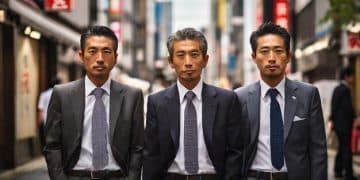Lost in Translation: Decoding Japanese Humor in J-Dramas

Lost in Translation? Common Misinterpretations of Japanese Humor in J-Drama Comedies arise from cultural differences, linguistic nuances, and the specific comedic styles employed, leading to audience confusion and a missed appreciation of the intended humor.
Japanese dramas, or J-dramas, have gained immense popularity worldwide. However, the unique brand of humor often found in these shows can sometimes be baffling for viewers unfamiliar with Japanese culture. This article delves into the world of J-drama comedies, exploring the common pitfalls and lost in translation? common misinterpretations of Japanese humor in J-drama comedies.
Understanding the Nuances of Japanese Comedy
Japanese comedy, much like humor anywhere, is deeply embedded in its culture and language. Its history and social context shape what is considered funny, and what might be lost on foreign audiences. Understanding these nuances is crucial for appreciating J-drama comedies.
The Foundation of Japanese Humor
Traditional Japanese comedic forms like *manzai* (a stand-up routine with a straight man and a funny man) and *rakugo* (a storytelling art) have significantly influenced J-drama humor. These forms rely heavily on wordplay, timing, and physical comedy.
Cultural Context is Key
Many jokes in J-dramas reference specific aspects of Japanese society, history, or folklore. Without this contextual knowledge, the punchline might fall flat. For example, self-deprecating humor, while universally relatable, takes on a particular form in Japan due to societal expectations of humility.
- Historical References: Jokes referencing historical events or figures.
- Social Norms: Humor based on playing with or subverting social expectations.
- Pop Culture: Allusions to popular trends, celebrities, or anime/manga.
The cultural gap can lead to misinterpretations. What might be seen as over-the-top or exaggerated in a J-drama can be perfectly normal within the context of Japanese entertainment.

Common Linguistic Hurdles in Translation
Language is more than just a tool for communication; it’s a vessel for culture. Translating humor can be incredibly challenging, as it often relies on subtle nuances that disappear when converted from one language to another.
Puns and Wordplay
Japanese is rich in homophones (words that sound alike but have different meanings), which are a goldmine for puns. However, these jokes are notoriously difficult to translate directly into English, often requiring extensive explanations or alternative jokes that don’t quite capture the original intent.
Honorifics and Levels of Formality
The Japanese language uses a complex system of honorifics, which indicate the speaker’s relationship and level of respect towards the listener. Jokes can arise from using inappropriate levels of formality or misinterpreting the social dynamics between characters. These subtleties are often lost in translation.
- Lost Nuance: The subtleties of honorifics disappear in direct translation.
- Cultural Misunderstanding: Foreign audiences might not grasp the social implications.
- Alternative Jokes Needed: Translators often have to create entirely new jokes.
The challenges of linguistic differences are further complicated by the fact that humor relies on split-second timing and delivery. A joke that works perfectly in Japanese might stumble in English due to different sentence structures and rhythmic patterns.
Exaggeration and Physical Comedy: Understanding the Styles
J-drama comedies often employ exaggerated acting, over-the-top reactions, and slapstick humor. While physical comedy is a global language, its specific manifestations can differ significantly across cultures. Understanding these stylistic differences is essential for appreciating the humor.
The Art of Overacting
In many J-dramas, actors deliberately exaggerate their facial expressions and body language for comedic effect. This can be off-putting to viewers accustomed to more subdued performances, but it’s an integral part of the comedic style.
Slapstick and Physical Gags
Slapstick humor, involving pratfalls, comical violence, and absurd situations, is another staple of J-drama comedy. Many of these gags are visually driven and require little to no dialogue, making them relatively easy to understand across cultural boundaries.
- Over-the-top Reactions: Actors exaggerate emotional responses.
- Physical Gags: Slapstick, pratfalls, and comical violence are common.
- Visual Storytelling: Many jokes are visually driven, requiring little dialogue.

However, the cultural context still plays a role. What might be considered harmless fun in Japan could be interpreted differently in other cultures, particularly when it comes to depictions of violence or gender roles.
The Role of Manzai and Tsukkomi in J-Drama Humor
Manzai, a traditional Japanese stand-up comedy style, has a strong presence in J-dramas, and understanding its components is crucial for interpreting the jokes. Particularly the *boke* (the funny one) and the *tsukkomi* (the straight man) relationship.
Boke and Tsukkomi Explained
The *boke* is the comedian who makes absurd statements or performs silly actions, while the *tsukkomi* is the straight man who corrects the *boke* with sharp retorts and often physical blows (usually lighthearted slaps or nudges). This dynamic creates a comedic rhythm that is familiar to Japanese audiences.
J-Dramas Adopt Manzai Elements
Many J-dramas incorporate the *boke* and *tsukkomi* dynamic into their characters and storylines. Characters might play the role of the *boke* by acting foolish or misunderstanding situations, while others play the *tsukkomi* by reacting with exasperation and sarcasm. This creates a sense of comedic tension and release.
- Boke: The funny man who makes absurd statements.
- Tsukkomi: The straight man who corrects the boke with sharp retorts.
- Comedic Tension: The dynamic creates a sense of comedic tension and release.
Without understanding the *manzai* framework, viewers might misinterpret the characters’ interactions or miss the humor altogether. For example, a character’s seemingly rude or aggressive behavior might actually be a playful *tsukkomi* response.
Lost in Translation: Specific Examples and Analysis
The abstract nature of humor can be difficult to translate perfectly, creating lost nuance. Examining specific examples where the joke does not cross cultures allows for greater understanding of the issues and challenges involved.
Case Study: Title Misunderstandings
One example is the translation of titles. Japanese titles often contain puns or wordplay that are difficult to translate directly. This can result in titles that don’t quite capture the essence of the show or even mislead viewers about the show’s content.
Example: Cultural References in Humor
Another common issue is the use of cultural references. J-dramas often make jokes about Japanese history, folklore, or popular culture. Foreign viewers who are unfamiliar with these references might miss the joke or misunderstand its meaning.
- Puns in Titles: Japanese title wordplay is hard to translate.
- Cultural References: Jokes of Japanese history are frequently not universal.
- Understanding the Context: The importance of context can be hard to know initially.
For example, a J-drama might make a joke about a famous historical figure or a popular anime series. If the viewer doesn’t know who the historical figure is or what the anime series is about, the joke will fall flat.
Tips for Better Understanding J-Drama Comedy
Although humor can be difficult to translate between cultures, the effort can be worthwhile. With cultural understanding and a willingness to immerse in J-dramas, one can better understand and appreciate the humor.
Do Your Research
Before diving into a J-drama comedy, take some time to research Japanese culture and humor. Learn about *manzai*, *rakugo*, and other traditional comedic forms. Familiarize yourself with common Japanese customs and social norms.
Watch with Subtitles
When watching J-dramas, always use subtitles. This will help you catch any linguistic nuances or cultural references that you might otherwise miss. Pay attention to the translator’s notes, as they often provide valuable context and explanations of jokes.
- Research Cultural Background: Learning key cultural points can deepen appreciation.
- Pay Attention to Subtitles: Subtitles convey context and nuances.
- Immerse Yourself In Media: The importance of more exposure.
The more J-dramas you watch, the better you’ll become at understanding Japanese humor. Over time, you’ll develop a sense of what’s considered funny and how jokes are delivered.
| Key Concept | Brief Description |
|---|---|
| 😂 Puns and Wordplay | Japanese humor heavily relies on puns that are hard to translate. |
| 🎭 Exaggerated Reactions | Over-the-top acting is a common comedic style in J-dramas. |
| 🎎 Cultural Context | Understanding Japanese culture is vital for grasping many J-drama jokes. |
| 🤣 Manzai Influence | Manzai comedy routines contribute to J-drama humor. |
Frequently Asked Questions
▼
Japanese humor often relies on cultural references, linguistic nuances, and comedic styles that may be unfamiliar to international viewers. This can lead to jokes being missed or misinterpreted without the proper context.
▼
‘Manzai’ is a traditional Japanese stand-up comedy style featuring a ‘boke’ (funny man) and a ‘tsukkomi’ (straight man). J-dramas frequently incorporate this dynamic, creating humor through the interplay between characters.
▼
The Japanese language uses honorifics to show respect. Jokes can arise from misusing or exaggerating these forms, which might not be immediately apparent to those unfamiliar with the language’s subtleties.
▼
Yes, exaggerated facial expressions and over-the-top acting are common in J-drama comedies. This is a deliberate choice to emphasize comedic timing and provide visual humour, although it may seem unusual to Western audiences.
▼
Researching Japanese culture, watching with subtitles, and immersing yourself in J-drama media can improve your understanding. Pay attention to cultural context and comedic styles to more fully appreciate the humor.
Conclusion
Understanding Japanese humor in J-dramas requires more than just linguistic translation; it demands cultural sensitivity and an appreciation for unique comedic styles. By familiarizing yourself with the nuances of Japanese society, comedic traditions, and linguistic subtleties, you can unlock a whole new level of enjoyment from these shows.





